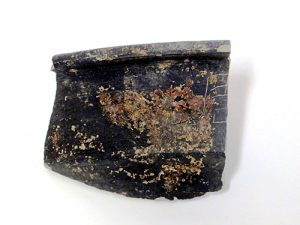Archaeologists discovered possibly the oldest use of a Kanji character on a pottery shard in Japan, dating back to the late Yayoi Pottery Culture period (300 BC-AD 300). The fragment was found at Karakami archaeological site in Iki, Nagasaki Prefecture, Japan.

The pottery fragment, 7.5 centimetres tall, 8.8 cm wide and 4 millimetres thick, was likely part of a bowl. The Kanji is believed to have been etched with a sharp tool on the finished piece. In the upper-right corner of the shard, the left half of the character for “shu” in Japanese, pronounced “zhou” in Chinese, was found. The fragment was discovered at the Karakami archaeological site with other relics, including artefacts made of iron. The site is believed to have been a settlement of that nation. Archaeologists believe that the shape of the bowl indicates that it was produced in an area around China’s Liaodong peninsula and then brought to Ikinoshima. The researchers state, that the dynasty called Zhou did not exist at that time in China, hence the kanji was highly likely to have been used for someone’s name.
(after Asahi Shimbun & Iki Board of Education)